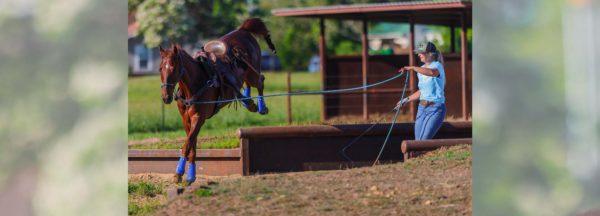Training Tip: Training Horse Jekyll and Hyde

Question: I took in a trainee with a serious bucking problem. I went through the full course of the Colt Starting Series and this horse’s groundwork is impeccable. It turns out that he hated things being above him, so we did the Sending Exercise with my partner on top of the roundpen for a solid week until he was confident. Then we did the first ride, and absolutely everything was beautiful. This horse has not bucked, reared, bolted or done anything with me or my colleagues on the ranch. He flexes, lopes right off, moves off my seat and legs, drops his poll when I pick up the reins, everything.
In the last week of a horse’s training, I have my client out to work hands-on with their horse. The day this horse’s owner pulled up to the barn, his mentality completely changed. He was anxious and impatient, and he threw me and my colleague. She refuses to work this horse with any pressure other than politely asking once. Did I do something wrong?
Answer: It sounds like you did a great job with this horse and followed all the steps. In cases like this, where the horse does well with his trainer but then acts totally different with another person, I’d say you didn’t get him “city-slicker broke.”
What I mean by that is you’re a professional and likely have a good seat and are confident when working with horses. The clients you train horses for aren’t always going to be great riders and will often lack confidence. Respect isn’t transferable with horses, and they notice every little change. This is especially true of horses with prior bad behavior. While this horse may have been responding well to you, when his owner started working with him and she didn’t have the same confidence and didn’t cue him the way you do, he noticed that.
It’s a lesson I learned the hard way as a young trainer, too. When I went out on my own, I did what I thought was a phenomenal job on a horse, and he performed great for me. However, when his owner, an older gentleman who wasn’t as athletic as me, came to ride him, it was a disaster. When he tried to get on the horse, he couldn’t get up in the saddle and ended up kneeing the horse in the gut. Well, I’d never done that to the horse before, so of course it startled him and he spooked, took off and dumped the guy on the ground.
After that experience, I went out of my way to expose areas where my training horses lacked confidence. I’d get on and off them sloppily, I’d flail my arms and legs against them while riding, I’d approach them quickly, and do anything I could think of that would startle them.
I also made sure the horses knew how to respond to cues that weren’t given textbook perfect. For example, when I wanted to lunge the horses, my body language made it clear that I wanted them to move and where I wanted them to go. I’d point up in the air with my hand, and off they’d go. Most people, especially beginners, aren’t going to have the same authoritative presence. So after the horses knew the exercises well, I’d get them used to responding correctly to half-assed cues. Maybe the person would point out to the side instead of high in the air when they wanted their horse to go out on a circle for lunging. The horses needed to know what that meant.
Basically, to prepare them for their owners, I acted like someone who’d never been around a horse before and got them city-slicker broke and responsive to sloppy cues. That way, by the time the owners would come out to ride their horses, the horses were confident about anything that could be thrown at them. So if the owner accidentally jerked on the reins, the horses didn’t rear up. If they leaned back in the saddle, the horses didn’t go into a bucking fit. If they didn’t cue them textbook perfect, the horses still knew what they were being asked to do and did it.
Getting a horse broke for any level of horseman to ride is one of the trickiest parts about training horses for the public. Just because a trainer can get a horse to do something doesn’t really mean a whole lot because at the end of the day it comes down to what the owner is able to do with their horse.
Remember, respect is not transferable. The horse’s owner has to prove to the horse that they are a leader and can move his feet to earn his respect. That’s why the Academy is so popular. We teach people how to train horses for the public and then how to teach owners to safely work with their horses.
That’s a long-winded way of saying it sounds like you followed the Method well and did exactly what you needed to do with this horse. Your mistake was in not taking his training a step further by making sure he was city-slicker broke. Experience is the best teacher; you’ll get it right next time.
Looking for more training tips? Check out the No Worries Club. Have a training question? Send it to us at [email protected].
